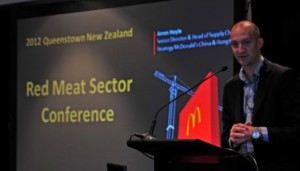 Keeping its consumers happy and listening to what they want has significantly improved McDonald’s business performance including financial returns, according to one of the company’s top China-based executives.
Keeping its consumers happy and listening to what they want has significantly improved McDonald’s business performance including financial returns, according to one of the company’s top China-based executives.
Introduced as a “good friend of New Zealand beef” at the Red Meat Sector Conference, Arron Hoyle, McDonald’s senior director and head of strategy for China and Hong Kong and a major customer for New Zealand’s lean manufacturing beef, said that the result deserved “a massive thank you to the New Zealand meat industry.”
McDonald’s had selected New Zealand and Australia as its sources of beef for the region because of the two countries’ reputations for food safety. While the US is still the largest market for the company, the company is significantly growing its presence in the APMEA countries.
In 1990, McDonald’s entered China, the fastest growing market in the world, when it opened its first store in Beijing. In 2010, it had 1,000 stores open and by 2013 will have 2,000.
All new stores will have a uniquely McDonald’s style, reflecting Chinese expectations for a modern, trendy image.
“We found that we need to ensure consistency in supply of style and expectations.”
There is no silver bullet, he went on to say. “You have to work extremely hard and to understand your consumer better than your husband or wife.”
He believes that New Zealand is well positioned to grow in Asia, particularly in China with its need to “import virtual water” due to ever growing water constraints as the country develops.
The Chinese market changes rapidly depending on the supply/demand dynamic. McDonald’s is forecasting beef growth to 7-8 million tonnes a year by 2020 and McDonald’s China demand alone to surpass 60,000 metric tonnes per annum.
McDonald’s likes to think it’s a great partner for NZ, says Hoyle, “the industry and all suppliers we partner with, we really like New Zealand beef. We don’t manage the supplier, we manage the business together in a partnership with suppliers.”
For the New Zealand beef team, it’s going to be a case of being better at the value chain, to execute against the opportunity, measure effectiveness versus efficiency and being faster than the competition to solutions.
“The data is showing us the opportunity is behind the hill. We need to work together to get there,” he said.
This article appeared in Food NZ magazine (August/September 2012).
